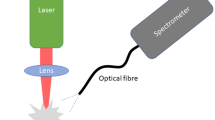Abstract
A thermal model of the initiation of lead azide by means of an electronic pulse is studied. The heattransfer equations, which take into account the burnup of the sample, are solved numerically. Equations are derived for the ignition criterion and for the delay times in the ignition of condensed explosive materials. It is shown that the thermal ignition cannot explain the short delay time in the lead azide initiation by means of an electron pulse.
Similar content being viewed by others
Literature Cited
A. V. Khaneft and V. G. Kriger, “Mechanism of low-threshold lead azide initiation with a laser pulse,” Proc. IV All-Union Conf. on Detonation. Telavi [in Russian], United Inst. of Chem. Phys. of the Akad. Nauk SSSR, Moscow (1988), Vol. 2, pp. 205–211.
E. I. Aleksandrov and A. G. Voznyuk, “Initiation of lead azide by laser radiation,” Fiz. Goreniya Vzryva,14, No. 4, 86–91 (1978).
A. V. Khaneft and V. G. Kriger, “Effect of spontaneous heating on the lead azide conductivity under nonisothermal conditions,” Chemical Reaction Kinetics; Proc. of the IX All-Union Symp. on Combustion and Explosion [in Russian], Chernogolovka, United Inst. of Chem. Phys. of the Akad. Nauk SSSR (1989), pp. 90–92.
A. A. Koval'skii, S. S. Khlevnoi and V. F. Mikheev, “The ignition problem of ballistic solid propellants,” Fiz. Goreniya Vzryva,3, No. 4, 527–541 (1967).
E. I. Aleksandrov and L. V. Serikov, “Investigation of the initiation mechanism in heavy metal azides using pulsed electron radiation,” Dielectrics under Extreme Conditions. Abstracts of the VI All-Union Conf. on the Physics of Dielectrics. Tomsk [in Russian] (1988), pp. 86–87.
V. S. Vavilov, Radiation Effect on Semiconductors [in Russian], Fizmatgiz, Moscow (1963).
V. N. Vilyunov, Ignition Theory for Condensed Materials [in Russian], Nauka, Novosibirsk (1984).
S. Patankar, Numerical Methods for Solving Heat Transfer and Fluid Dynamics Problems [Russian translation], Énergoatomizdat, Moscow (1984).
R. M. Bayazitov, M. I. Ibragimov and I. B. Khaibullin, “Methods for calculating the temperature fields during pulsed light irradiation of semiconducting ion-alloyed layers,” Kazan, KFT, 1981, Dep. in All-Union Inst. Scient. Techn. Info. on Sept. 29, 1981, No. 4716-81.
S. M. Ryabykh and K. Sh. Karabukaev, “Kinetics of explosive decomposition of silver and lead azides initiated by electron pulses,” Radiation Stimulation Effects in Solid Bodies [in Russian], UPI, Sverdlovsk (1988), pp. 51–55.
Additional information
Kemerovo. Translated from Fizika Goreniya i Vzryva, Vol. 29, No. 5, pp. 63–66, September–October, 1993.
Rights and permissions
About this article
Cite this article
Khaneft, A.V. Initiation of lead azide using an electron pulse. Combust Explos Shock Waves 29, 610–613 (1993). https://doi.org/10.1007/BF00783715
Received:
Issue Date:
DOI: https://doi.org/10.1007/BF00783715




